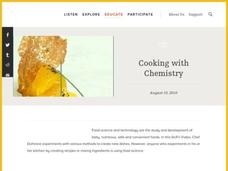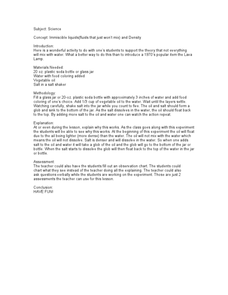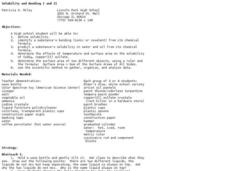Curated OER
The Unmixables: Investigating Immiscible Liquids
Students build an understanding of the properties of liquids and research the immiscible properties of different milks through group experiments. In this immiscible liquids experiment, students investigate what happens when certain...
Science Friday
Cooking with Chemistry
Use class time to perfect your hollandaise sauce with a chemistry lesson. It includes two activities to teach about immiscible liquids, emulsifiers, and creating a stable homogenous mixture. Young scientists first mix liquids in a...
Curated OER
Immiscible Liquids and Density
Students will make a lava lamp. In this density lesson, students will combine water and oil and make observations, then add salt to the oil and observe the oil sink, then float again when the salt dissolves in the water.
Curated OER
Heterogeneous Equilibrium: Measurement of a Partition Coefficient
In this chemistry worksheet, students examine a concept in science and then use the knowledge in application by conducting an experiment.
Curated OER
#24 How Much Air Is In Foamed Polystyrene Products?
Students are challenged to come up with a good estimate of the amount of air in foamed polystyrene products. They use this gas evolution experiment and as such have students measure the gas generated when foamed polystyrene is degassed...
Curated OER
Chapter 12 Review, Mixed Review: Solutions
Although there are only six questions on this chemistry handout, it makes a thorough review of solutions. Novices explain why a compound is not an electrolyte, identify types of compounds, and calculate moles, grams, and molalilties in...
Teach Engineering
Density and Miscibility
The liquids did not mix — so what do density columns have to do with it? The seventh part in a series of nine provides the theoretical explanation of why density columns do not mix. The lesson covers the topics related to mixing and...
Teach Engineering
Density Column Lab - Part 1
Mass and density — aren't they the same thing? This activity has groups use balance beams and water displacement to measure several objects. The pupils use the measurements to calculate the density of the objects.
Teach Engineering
Density Column Lab - Part 2
Groups suspend objects within layers of liquids to determine the densities of different liquids and compare them to the densities of objects calculated in Part 1. The groups then carefully test their calculations by layering the liquids...
Fuse School
Quiz: Emulsions
Ready to mix it up? Learners step up to the plate and show what they know in the 12th installment of a 14-part series covering the states of matter. The quiz contains four questions testing the basics of emulsion chemistry.
Curated OER
Chemistry 115 Practice Exam 3
Radioactive decay, pH, properties of elements, organic compounds, and stoichiometry are all touched upon through this practice chemistry exam. It always helps learners to take a practice test in preparation for the actual exam. This...
Curated OER
Making Mayonnaise - An Edible Emulsion
Students find a way to mix oil and water. In this emulsion lesson, students attempt to mix oil and water, then add egg yolk to the mixture to serve as an emulsifier and observe the results.
Curated OER
Mixed Review-Chemistry
In this chemistry review worksheet, students answer a variety of questions about matter, elements, the kinetic theory, chemical and physical properties and the distillation process. They complete a concept map about matter.
Curated OER
What is Soap?
Students investigate soap, how it is made and its structure. In this soap activity, students observe a demonstration of soap being made. Students observe the properties of soap and how soap performs in "real-life" situations like cutting...
Curated OER
Ocean in a Bottle
Young scholars investigate pollution in water. In this pollution lesson, students participate in an experiment to simulate water pollution. Young scholars observe how the water reacts to the "pollution."
Curated OER
The Nature Of Dissolving Processes
Young scholars examine the rule of "like dissolves like." They define and describe solutions and solubility models on molecular liquids, ionic solids, and molecular solids.
Curated OER
Through Thick or Thin!!!
Young scholars differentiate between high and low viscosity. Students collect, graph, and interpret data, then quantitatively measure polymer solids. Young scholars experiment with a household example of an emulsion polymer.
Curated OER
Ocean in a Bottle
Learners create an enclosed ocean in a bottle and add different pollutants to explore the effects of pollution on the environment.
Curated OER
Ions in the Environment
Students explain the importance of the five main biogeochemical cycles. In this chemistry lesson, students discuss how ions are transported in the environment. They design an experiment to collect data on eutrophication.
Curated OER
A Solution for Precipitation
Students predict the product of chemical reaction using the solubility rules. In this chemistry lesson, students balance ionic equation. They perform a lab to check if their predicted products are correct.
Curated OER
A Solution for Moles
Learners calculate the concentration of different solutions. In this chemistry lesson plan, students explain what a solution is. They explain ways to change the concentration of a solution.
Other popular searches
- Immiscible Properties
- Miscible and Immiscible Liquid
- Miscible and Immiscible
- Immiscible Liquids
- Chemistry Immiscible
- Solutions Immiscible























